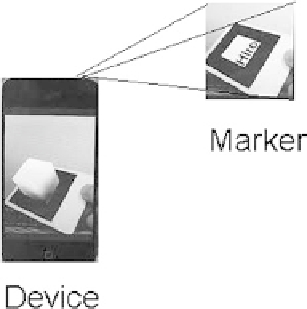Game Development Reference
In-Depth Information
Figure 9-1.
Components of a basic AR app
Three elements are illustrated in Figure
9-1
.
Marker
: This is a real world object (usually a printed card with some kind
of pattern) that is used to render the virtual object. As the marker moves
in 3D space so does the virtual object bound to it.
Phone or device
: The mobile device with a video camera where all the
action takes place.
Software
: This may include the computer vision algorithms that calculate
the real camera position and orientation relative to the physical marker
in real time.
AR is in its infancy in the mobile world, making it virgin ground for a wide range of
applications. Some of the applications today include?
AR
browsers
: Here is where all the hype got started in mobile. An AR
browser is a neat application that lets you use your camera to render
geo-coded information on top of video in real time. For example, you
could be walking along in the city looking for your favorite restaurant.
Instead of searching for it on a map, you could start the video feature in
your AR browser, and as you move around, the browser would render
information about your specific location such as points of interest,
hospitals, restaurants, etc. With a simple click, you could select the
restaurant, make a reservation, and take a look at the menu.
AR gaming
: Here is where things get really interesting. By merging the
real world and the game world, augmented reality lets you discover new
ways of enjoying casual games.


